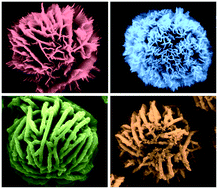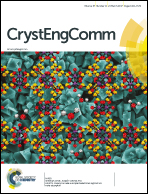Structural study of TiO2 hierarchical microflowers grown by aerosol-assisted MOCVD†
Abstract
TiO2 is a promising n-type semiconductor for optoelectronic devices, in particular dye sensitized and hybrid solar cells, and more recently for hybrid perovskite-based solar cells, as well as for lithium batteries. For these applications, TiO2 structures offering a high mesoporosity and surface area are especially interesting as these increase the efficiency of phenomena taking place at the interfaces. We have used aerosol-assisted metal–organic chemical vapor deposition (AA-MOCVD) to deposit TiO2 films containing hierarchical TiO2 microflowers. Both the film and the microflowers crystallize in the anatase structure. The microflowers have diameters of around 2–3 microns while the petals are only several nanometers thick. The density of the microflowers and of the petals in each flower can be controlled by adjusting the deposition parameters. These microstructures are stable under high temperature annealing (950 °C). In this communication, we describe the synthesis of the microflowers and present the detailed study of their structural and morphological properties.



 Please wait while we load your content...
Please wait while we load your content...